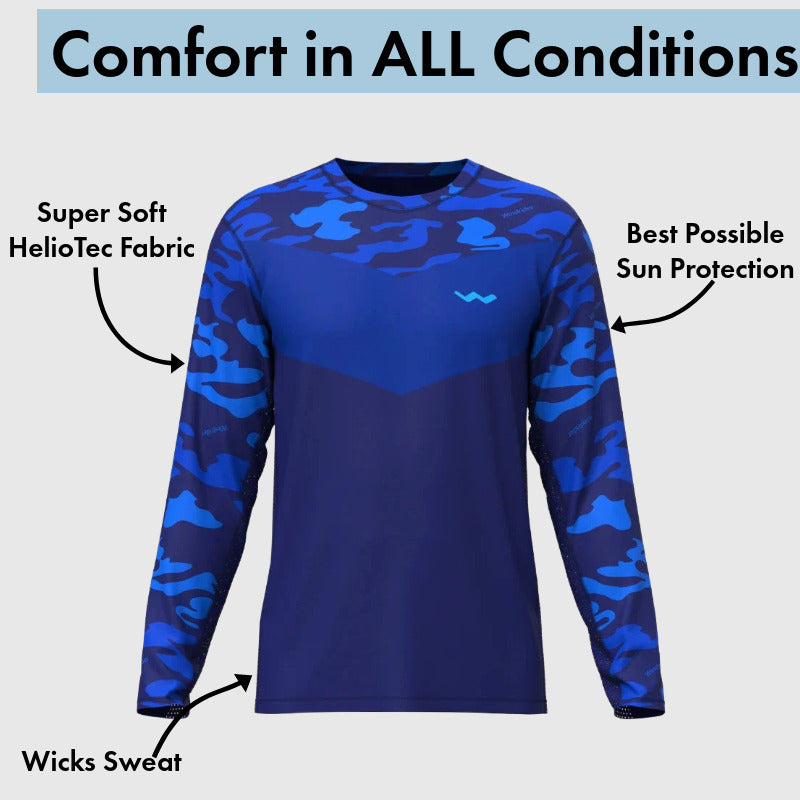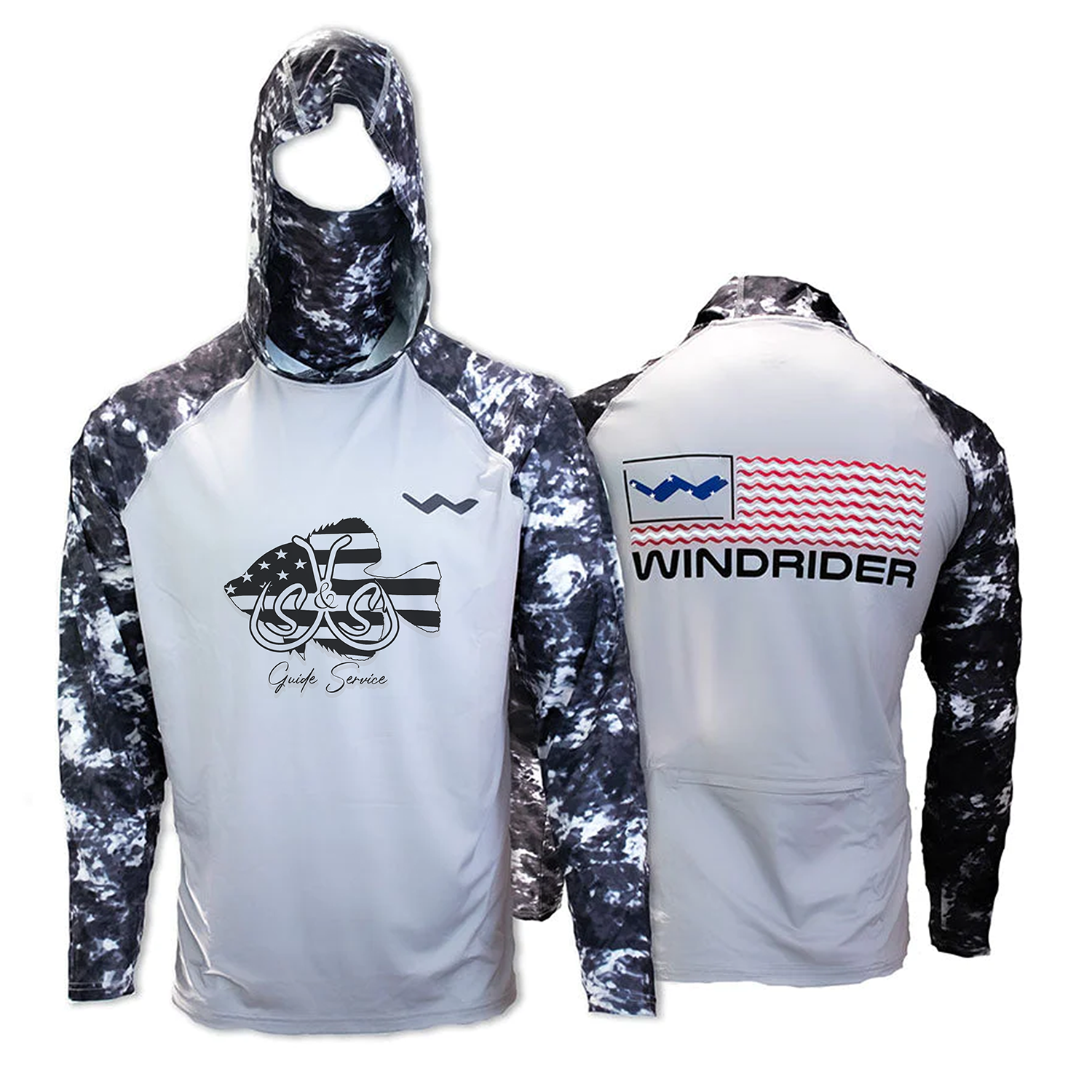Understanding the Low-Angle Sun Problem

When sun hangs low on the horizon at sunrise or sunset, its light comes at you from a horizontal angle. Your baseball cap, designed to shield from overhead sun, suddenly feels nearly pointless. Those low-angle rays slip beneath the brim, hitting your cheeks, nose, chin, neck, and eyes with direct intensity.
Water's surface amplifies UV exposure by reflecting light and adding glare. When sun is low early morning or late evening, its rays strike water at an angle, turning the surface into a mirror that flings UV radiation straight up into your face. So even while you're mesmerized by golden hour glow that makes photographs look irresistibly appealing, you're still receiving steady UV doses on areas that would normally stay protected during midday fishing.
Dermatologists point out that fishermen who work water at sunrise or twilight often exhibit accelerated aging and higher rates of skin cancers on lower face and neck. Those anglers tell themselves they're escaping the sun because it "doesn't feel that hot," yet they're actually bathing the most vulnerable parts of their faces in substantial UV radiation.
UV Intensity at Sunrise and Sunset: The Numbers
The belief that sunrise and sunset present negligible UV risk is dangerously mistaken. Though UV intensity fades as sun sinks toward horizon, meaningful doses of UV radiation linger longer than most people imagine.
UV radiation reaches 50% of its peak when sun is just 30° above the horizon. In summer at mid-latitude locations, this occurs 2 hours after sunrise and again about 2 hours before sunset. So classic dawn-and-dusk fishing windows actually place you in UV conditions equivalent to those you'd find at 10 AM or 3 PM—hours when most anglers would never contemplate fishing without protection.
The crucial distinction lies in perceived warmth. When fishing at dawn or dusk, air feels comfortably cool, conjuring the illusion that sun's impact is minimal. Your skin fails to register the sting that scorching midday sun would deliver. Still, UV radiation works independently of temperature—if UV Index is the same, serious sunburn can occur at 65°F as readily as at 95°F.
Even a 3-hour sunrise fishing outing—5:30 AM to 8:30 AM in summer—still delivers about 60-70% of the UV dose that a midday session of the same length would provide. That's a significant amount of sun, especially since most of it hits the face, an area a hat can't shield.
Why Golden Hour Light Can Damage Skin Uniquely
Photographers cherish golden hour for its warm, flattering illumination. Sun's shallow angle stretches shadows into elongated bands and bathes scenes in richly saturated hues. Yet that very low angle funnels ultraviolet radiation onto upright surfaces, delivering concentrated doses to skin on your face and neck.
When sun perches overhead at midday, UV radiation spreads across your head, shoulders, arms, and torso. Your hat throws protection over your face, reducing most direct exposure. No single region bears disproportionate burden.
At daybreak and twilight, ultraviolet radiation focuses on the upright expanse of face and neck. Those regions—more tender and more predisposed to skin cancer than arms or back—absorb roughly 3-4 hours of concentrated exposure during prime fishing windows.
The Helios Long Sleeve Sun Shirt addresses the issue by wrapping arms and torso in solid protection, freeing you to concentrate sunscreen on the only exposed areas—face and neck. That focused approach delivers better coverage of those vulnerable spots during low-angle sun exposure.
The Drive to the Fishing Spot: A Hidden Factor
Many dawn fishing expeditions launch before sun even peeks over horizon, starting with a drive to the boat ramp or chosen spot. As you navigate those roads, newborn sun slips through vehicle windows, brushing your left arm and face (if you're driving in the US and other right-hand-traffic nations).
Window glass blocks UVB but lets 70-90% of UVA slip right through. That UVA quietly builds up damage, speeds skin aging, and nudges skin cancer development. Drivers and salespeople who spend hours daily in sunlight through vehicle windows end up with markedly accelerated aging and noticeably higher cancer incidence, especially on the left side of their bodies.
Fishermen who habitually launch into dawn, navigating trips to fishing haunts, accumulate identical cumulative exposure. Even a 30-45 minute drive with sunrise hitting your left arm more than 100 times per year silently stacks into substantial UV toll that adds up over the long haul of a fishing life.
Long-sleeve fishing shirts eliminate that exposure completely. Slip on your UPF 50+ shirt before you even leave the house and you'll stay protected through the drive, boat launch, and entire fishing session. No need to remember to slather sunscreen on arms while rushing to hit the best dawn bite window.
Browse our ice gear collection for more options.
Temperature Comfort During Cool Dawn and Dusk Hours

A typical complaint about long-sleeve fishing shirts for dawn-and-dusk outings is fear of overheating. When air is already cool and pleasant, why bother with extra sleeves?
Truth be told, a quality technical fishing shirt stays comfortable over a wide temperature band. Its moisture-wicking, quick-dry fabric regulates heat well, keeping you comfortable from around 60°F up to 95°F. At sunrise when air hovers between 65°F and 75°F, the lightweight shirt feels perfectly neutral—neither warm nor cool, just comfortably balanced.
As sun climbs and temperature rises, the shirt's built-in cooling advantage becomes a lifesaver. By mid-morning, even if you're still on water and mercury is flirting with 85°F or higher, you'll already be dressed in gear that keeps you comfortable—far better than sweating in the cotton tee you wore for the cool dawn launch.
Much the same goes for sunset fishing trips: they usually kick off in lingering warmth of afternoon then gradually grow cooler as night falls. A long-sleeve fishing shirt keeps you comfortable through that temperature swing with no need to add or swap layers midway through the session.
The deciding factor is fabric weight. Shirts at 6-8 oz tend to trap heat, which can be uncomfortable during early-morning or twilight trips on water. In contrast, ultra-light options in the 3-4 oz range—like the Helios—still block sun but stay cool, making them suitable for virtually any fishing scenario.
Protecting Your Arms Through Extended Sessions
Dawn-or-dusk outings rarely wrap up in 30-45 minutes. As soon as the bite picks up during those prime windows, you tend to linger on water. A sunrise trek that starts at 6 AM often rolls on until 10 AM—or even later—as you chase active fish. That 4-hour stretch can dump substantial UV doses onto any skin left uncovered.
Arms tend to accumulate attention during marathon fishing trips simply because they're constantly out in the open and active. Every cast, every haul, every fish you wrestle, and all the gear you juggle keep your arms moving and soaking up whatever sunlight is available. In contrast, your face can turn away or be shaded at various moments, but your arms stay fully exposed the whole time.
In practice, slathering sunscreen onto arms is hassle; a splash of water, constant grip on rod, and even light sheen of sweat whisk it away instantly. The rule-of-thumb advises recoating roughly every 90 minutes, yet most anglers either forget or simply aren't inclined to pause for reapplication while in thick of action. The outcome? Arms that feel perfectly fine in morning light end up reddened and uncomfortable by the time afternoon sun climbs.
Long-sleeve shirts tackle the issue with protection that needs no upkeep or reapplication. Slip the shirt on once and your arms stay protected for the whole session, no matter how long it lasts.
Guarding Face and Neck When Sun Is Low
While a long-sleeve shirt shields arms and torso, it leaves face and neck exposed to low-angle sunlight. Anglers who worry about facial sun damage at dawn or dusk will find that a hooded fishing shirt offers superior protection.
The Hooded Helios with Gaiter and Atoll Hooded Shirt both deliver all-day sun coverage that shifts with sun's angle during your fishing session. When low-angle sun starts to burn, pull hood and gaiter into place for protection. As light climbs higher or dips lower and glare eases, you can tuck gaiter away while keeping hood in place.
This adaptable protection matches the variable conditions of dawn and dusk fishing better than fixed solutions like hats or sunglasses alone.
Glare Management and Eye Protection
Low-angle sunlight creates intense glare off water surfaces, making it difficult to see fish, structure, and underwater features. Quality polarized sunglasses address this problem but don't eliminate UV exposure to surrounding facial areas.
The skin around your eyes—particularly thin skin on eyelids and temples—is among the most vulnerable to sun damage on your entire body. Low-angle sun hits this area directly during dawn and dusk sessions. Many anglers develop significant aging and damage around their eyes despite religious sunglass use, because glasses don't protect adjacent skin.
A hooded fishing shirt—or carefully applied sunscreen around eyes—has become indispensable for anglers who spend bulk of time on water during golden hours. This comprehensive shield curtails cumulative damage that only becomes evident after years of dawn-and-dusk fishing.

